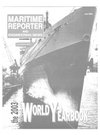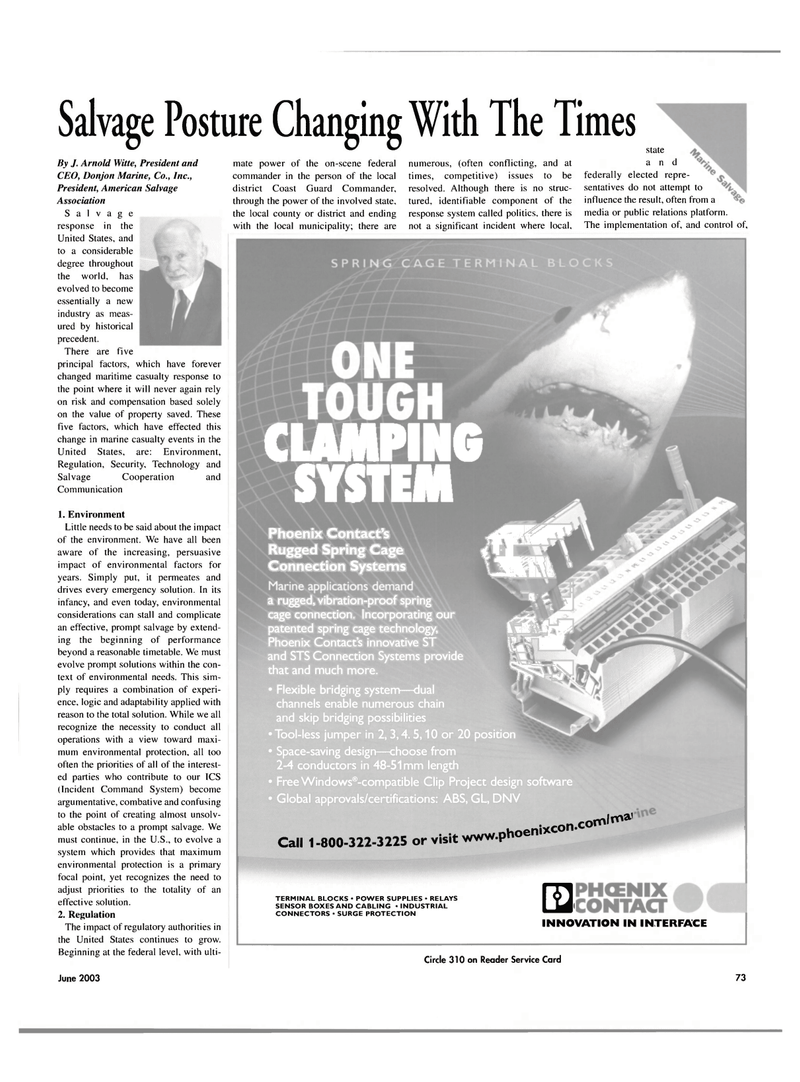
Page 73: of Maritime Reporter Magazine (June 2003)
Read this page in Pdf, Flash or Html5 edition of June 2003 Maritime Reporter Magazine
•
CLAMPING
SYSTEM
Phoenix Contact's ^R^
Rugged Spring Cage t/|-|
Connection Systems ^ ' a rugged, vibration-proof spring £ jj cage connection. Incorporating our ^^ patented spring cage technology, ii fn^
Phoenix Contact's innovative ST ^ ""^JH and STS Connection Systems provide that and much more. ^^^A^M • Flexible bridging system—dual channels enable numerous chain and skip bridging possibilities • Tool-less jumper in 2,3,4.5,10 or 20 position • Space-saving design—choose from 2-4 conductors in 48-51 mm length • FreeWindows®-compatible Clip Project design software • Global approvals/certifications: ABS, GL, DNV
Call 1-800-322-3225 or visit www .phoenixcon.co ml^1
Salvage Posture Changing With The Times state
By J. Arnold Witte, President and
CEO, Donjon Marine, Co., Inc.,
President, American Salvage
Association
Salvage response in the
United States, and to a considerable degree throughout the world, has evolved to become essentially a new industry as meas- ured by historical precedent.
There are five principal factors, which have forever changed maritime casualty response to the point where it will never again rely on risk and compensation based solely on the value of property saved. These five factors, which have effected this change in marine casualty events in the
United States, are: Environment,
Regulation, Security, Technology and
Salvage Cooperation and
Communication
TERMINAL BLOCKS • POWER SUPPLIES • RELAYS
SENSOR BOXES AND CABLING • INDUSTRIAL
CONNECTORS • SURGE PROTECTION and federally elected repre- sentatives do not attempt to influence the result, often from a media or public relations platform.
The implementation of, and control of.
INNOVATION IN INTERFACE mate power of the on-scene federal commander in the person of the local district Coast Guard Commander, through the power of the involved state, the local county or district and ending with the local municipality; there are numerous, (often conflicting, and at times, competitive) issues to be resolved. Although there is no struc- tured, identifiable component of the response system called politics, there is not a significant incident where local. a 1. Environment
Little needs to be said about the impact of the environment. We have all been aware of the increasing, persuasive impact of environmental factors for years. Simply put, it permeates and drives every emergency solution. In its infancy, and even today, environmental considerations can stall and complicate an effective, prompt salvage by extend- ing the beginning of performance beyond a reasonable timetable. We must evolve prompt solutions within the con- text of environmental needs. This sim- ply requires a combination of experi- ence, logic and adaptability applied with reason to the total solution. While we all recognize the necessity to conduct all operations with a view toward maxi- mum environmental protection, all too often the priorities of all of the interest- ed parties who contribute to our ICS (Incident Command System) become argumentative, combative and confusing to the point of creating almost unsolv- able obstacles to a prompt salvage. We must continue, in the U.S., to evolve a system which provides that maximum environmental protection is a primary focal point, yet recognizes the need to adjust priorities to the totality of an effective solution. 2. Regulation
The impact of regulatory authorities in the United States continues to grow.
Beginning at the federal level, with ulti-
Cirde 310 on Reader Service Card
June 2003 73

 72
72

 74
74
